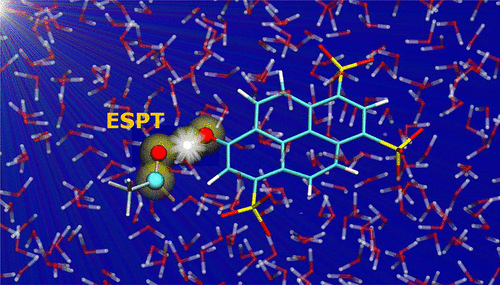当前位置:
X-MOL 学术
›
J. Phys. Chem. B
›
论文详情
Our official English website, www.x-mol.net, welcomes your
feedback! (Note: you will need to create a separate account there.)
Structural Origin and Vibrational Fingerprints of the Ultrafast Excited State Proton Transfer of the Pyranine-Acetate Complex in Aqueous Solution
The Journal of Physical Chemistry B ( IF 2.8 ) Pub Date : 2021-09-02 , DOI: 10.1021/acs.jpcb.1c05590 Maria Gabriella Chiariello 1 , Greta Donati 1 , Umberto Raucci 1 , Fulvio Perrella 1 , Nadia Rega 1, 2
The Journal of Physical Chemistry B ( IF 2.8 ) Pub Date : 2021-09-02 , DOI: 10.1021/acs.jpcb.1c05590 Maria Gabriella Chiariello 1 , Greta Donati 1 , Umberto Raucci 1 , Fulvio Perrella 1 , Nadia Rega 1, 2
Affiliation

|
The excited state proton transfer (ESPT) reaction from the photoacid 8-hydroxypyrene-1,3,6-trisulfonic acid (HPTS or pyranine) to an acetate molecule has been investigated in explicit aqueous solution via excited state ab initio molecular dynamics simulations based on hybrid quantum/molecular mechanics (QM/MM) potentials. In all the trajectories, the direct proton transfer has been observed in the excited state within 1 ps. We find that the initial structural configuration extracted from the ground state distribution strongly affects the ESPT kinetics. Indeed, the relative orientation of the proton donor–acceptor pair and the presence of a water molecule hydrogen bonded to the phenolic acid group of the pyranine are the key factors to facilitate the ESPT. Furthermore, we analyze the vibrational fingerprints of the ESPT reaction, reproducing the blue shift of the acetate CO stretching (COac), from 1666 to 1763 cm–1 testifying the transformation of acetate to acetic acid. Finally, our findings suggest that the acetate CC stretching (CCac) is also sensitive to the progress of the ESPT reaction. The CCac stretching is indeed ruled by the two vibrational modes (928 and 1426 cm–1), that in the excited state are alternately activated when the proton is shared or bound to the donor/acceptor, respectively.
中文翻译:

醋酸吡喃复合物在水溶液中超快激发态质子转移的结构起源和振动指纹
通过基于激发态的从头算分子动力学模拟,在显式水溶液中研究了从光酸 8-羟基芘-1,3,6-三磺酸(HPTS 或吡喃)到乙酸盐分子的激发态质子转移 (ESPT) 反应混合量子/分子力学 (QM/MM) 势。在所有轨迹中,在 1 ps 内在激发态下观察到直接质子转移。我们发现从基态分布中提取的初始结构构型强烈影响 ESPT 动力学。事实上,质子供体-受体对的相对取向和与吡喃酚酸基团键合的水分子氢的存在是促进 ESPT 的关键因素。此外,我们分析了 ESPT 反应的振动指纹,CO拉伸 ( CO ac ),从 1666 到 1763 cm –1证明醋酸盐转化为醋酸。最后,我们的研究结果表明醋酸盐CC拉伸(CC ac)也对 ESPT 反应的进程敏感。所述CC交流拉伸通过两个振动模式(928和1426厘米确实排除-1),即处于兴奋状态时,质子被分别共享或结合到供体/受体,被交替地激活。
更新日期:2021-09-16
中文翻译:

醋酸吡喃复合物在水溶液中超快激发态质子转移的结构起源和振动指纹
通过基于激发态的从头算分子动力学模拟,在显式水溶液中研究了从光酸 8-羟基芘-1,3,6-三磺酸(HPTS 或吡喃)到乙酸盐分子的激发态质子转移 (ESPT) 反应混合量子/分子力学 (QM/MM) 势。在所有轨迹中,在 1 ps 内在激发态下观察到直接质子转移。我们发现从基态分布中提取的初始结构构型强烈影响 ESPT 动力学。事实上,质子供体-受体对的相对取向和与吡喃酚酸基团键合的水分子氢的存在是促进 ESPT 的关键因素。此外,我们分析了 ESPT 反应的振动指纹,CO拉伸 ( CO ac ),从 1666 到 1763 cm –1证明醋酸盐转化为醋酸。最后,我们的研究结果表明醋酸盐CC拉伸(CC ac)也对 ESPT 反应的进程敏感。所述CC交流拉伸通过两个振动模式(928和1426厘米确实排除-1),即处于兴奋状态时,质子被分别共享或结合到供体/受体,被交替地激活。











































 京公网安备 11010802027423号
京公网安备 11010802027423号